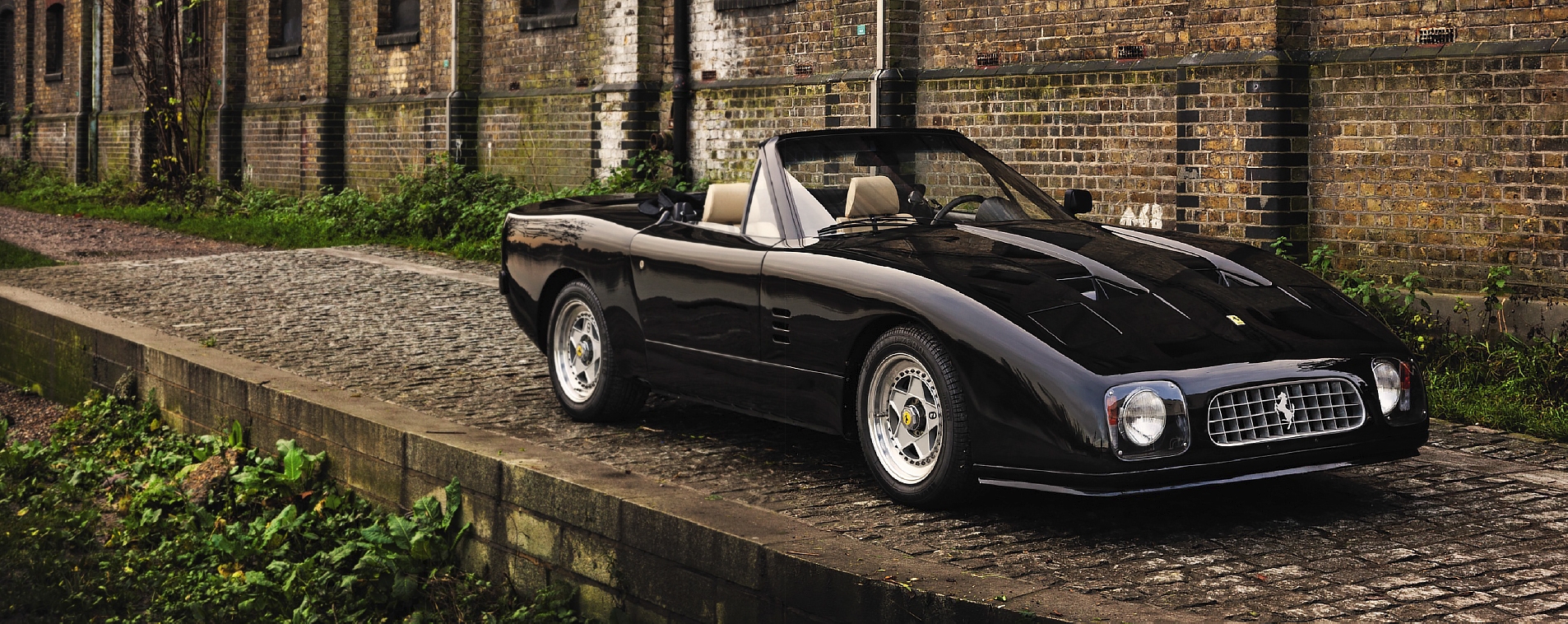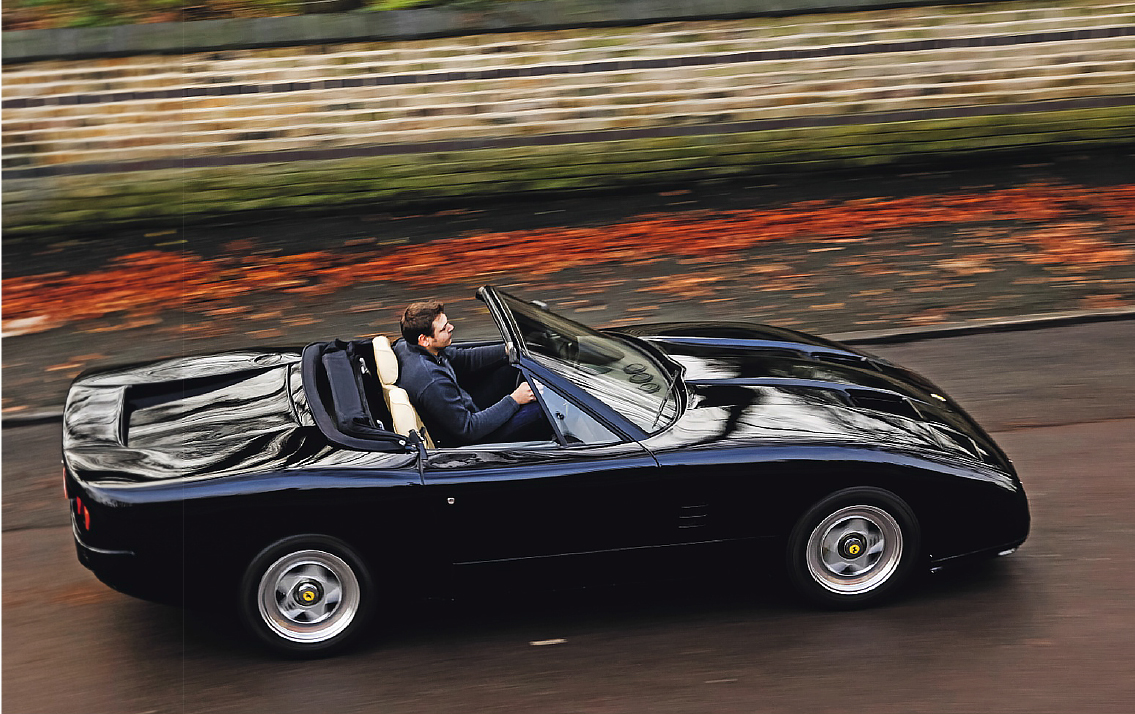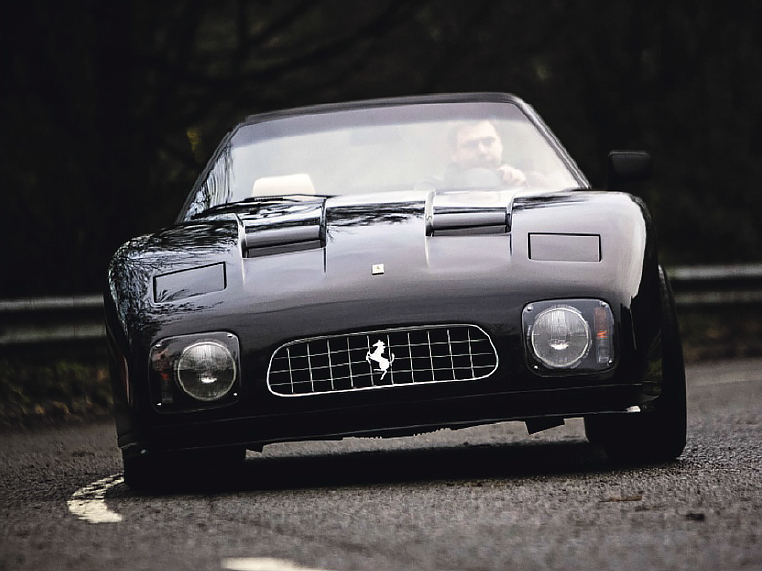
Grand Design. What do you do if don’t like your Ferraris off-the-peg? Style and build your own, of course! Alastair Clements samples Luigi Chinetti Jnr’s reinterpreted 365GT 2+2. Photography Tony Baker/LAT/RM auctions. For some, the Mona Lisa’s enigmatic smile isn’t charming, it’s irritating. Others might suggest that a suspended ceiling would be more practical than the painted plaster of the Sistine Chapel, that Picasso’s portraits would benefit from a bit of symmetry, or that Michelangelo’s David really ought to put on some clothes. Art is subjective, after all, so why should automotive sculpture be any different?

Certainly that’s what Luigi Chinetti Jnr – also known as ‘Coco’ – thought, when presented with the staple Pininfarina designs from Maranello. Yes, they were conventionally elegant, but not always particularly up-to-date, or accurately targeted towards the North American market that he and his father had so successfully cultivated as the local importers. And his family certainly had form. The name of the North American Racing Team – NART – is as famous among the classic enthusiasts of 2014 for its roof-chops of the iconic 275GTB/4 as it is for its competition exploits. After all, a NART Spyder now holds the record auction price for a road car, with RM in Monterey last year securing £17.6m for one of the 10 built.
From top: NART crest always means something special; twin distributors and twin filters for V12; digital tachometer at base of speedo; quad lamps.
Which makes the near-£400k that Coys is asking for this particular NART Spyder look like something of a bargain. Particularly when you consider that it’s more powerful – based on a 320bhp 365 rather than the 300bhp 275 – and rarer, with a ‘production’ run of just two. And until Chinetti finishes his latest project, it is also the last NART Spyder built…
Chassis 12605 started life on 6 June 1969 as one of the 801 Ferrari 365GT 2+2s built, with its elegant chiusa (closed) Pininfarina-styled coach- work finished in Grigio Mahmoud and the interior trimmed in blackleather. Some 16years later this car, along with chassis 12611, was dispatched to Italy to be reborn as the 365GT NART Spyder, or 365GT 2+2 Speciale.
The mission wasn’t simply a restyle, however, but a reinvention. Coco’s father Luigi Snrwon Le Mans three times and Luigi Jnr was something of a speed freak himself, setting records in a NART 512 at Bonneville in 1974 alongside Graham Hill and Paul Newman, plus taking a class win at Le Mans in 1971 with a Daytona. Coco was able to see through the 365’s heavy steel coupe body – laden with four leather seats, air-conditioning, power steering, servo brakes and electric windows – to the light tubular chassis and potent all-alloy V12 beneath. In a world of ever-increasing automotive complexity, he wanted to go back to basics.
“What we wanted to do was to make things simple,” explains Chinetti, speaking today from his home in Quebec, Canada. “And this car was the essence of simplicity- there’s nothing there! It follows the ethos of the classic European sports car: a vehicle made purely to have fun with, to just get in and drive.
“It would have been nice to use a GTC because it was already a short car, but they were expensive and there weren’t many around. We were going to change everything, so it made sense to use a cheaper chassis. The whole thing was a real ‘why not?’ It’s no different to the British specialist sports car industry, or the American hot-rod scene. I have the people, I have the ability to get it done. It costs a lot of money, but it’s a fun thing to do.”

Fun, perhaps, but surely brave as well? “It is difficult to do something like this with a Ferrari,” Chinetti concurs. “In part that’s because people are afraid of the factory – which is not a problem for me with my name.” Ah yes, the name. The Chinetti/NART brand is the irresistible force that can shift even the immovable object of Maranello. Enzo gave his blessing to the 10 275GTB/4 NART Spyders, and Ferrari is reputed to have sanctioned the same number of NART 365s. This is reinforced by a ‘Certificate of origin’ issued by Ferrari SpA in September 1990, in which the car is defined as ‘Modifica aperta NART 1988-89’ with the key stamp ‘Product design and development approved’ and the Ferrari logo. Not that 10 cars were ever built – or indeed planned, as Chinetti points out: “A production run in my league is three or four cars, but I’m quite happy if only one is built!”
Having been initiated in the mid-’80s the project took just six months to get from Coco’s first sketches to a 1:5-scale clay styling model, made in France. But to actually build his fantasy machine, where else could Chinetti turn but to the roots of Ferrari – and indeed the origins of the Italian specialist sports car industry: Modena, Emilia-Romagna. Founded by Franco Bacchelli and Roberto Villa, Carrozzeria AutoSport had already proved its craftsmanship for NART by constructing its 512BB LM sports-racing cars, so was the obvious choice to tackle the 365 Speciale in its Bastiglia workshops.
By 1987, the layout was beginning to take shape. The tubular steel chassis was shortened and beefed up with square-tube reinforcements to make up for the strength lost by removing the standard car’s roof – yet the whole frame still weighed in at just 110kg. “We kept the driveline and the pick-up points pretty much stock,” recalls Chinetti, “but made the rest of it very sturdy.” The all-independent double-wishbone suspension was retained, albeit with new geometry, along with the five-speed gearbox (notably not a transaxle, as in the short-chassis GTC/ GTS) that delivered its power through a Gleason Torsen limited-slip differential.
As much of the mass as possible was kept within the wheelbase to aid the Ferrari’s handling, with the engine set well back and the 98-litre fuel tank mounted directly behind the driver, then the hand-beaten aluminium body was stretched as tightly as possible over the mechanicals, lopping a full half a metre from the factory car’s 4980mm length.

“I guess a standard 365GT 2+2’s weight is in the mid-3000lbs,” says Coco. “With this car we got that down to 2400-2600lb, so it was very nimble. That was always part of the deal, to make it lightweight.” The gorgeous 4390cc V12 beneath that huge forward-hinged clamshell bonnet wasn’t left alone either, with tweaks to its triple twin-choke Weber carburettors, mild tuning and bespoke tubular manifolds with side-exit exhausts combining to liberate anything from 340-360bhp depending on who you believe, meaning 0-60mph in 6 secs.
For all its technical interest, the most arresting aspect of the Nart is its looks
Profile should have dipped lower at the А-post to give a sleeker line; 308 ‘screen is neatly integrated. Left: rear wings sweep up to meet short central spoiler
Reports differ on whether 12605 or its sister car was completed first in 1988, but part way through the build Chinetti was introduced to a couple of German enthusiasts, who immediately snapped up a car each as an investment. Today, 12611 is certainly the more famous. Finished in red with black trim rather than this car’s more sober black with tan, it also sported wacky all- enveloping wheel spats that gave a bizarre look to the rear. It was soon featuring on magazine covers, from Automobile to Lui, and changed hands several times, later moving to the USA. In contrast, 12605 remained in Germany for virtually its whole life – where it still resides today.
Spyders web
The North American Racing Team dates back to 1958, and the NART Spyder saga began soon after. Having influenced the factory’s decision to build the 250GT California Spider, Chinetti Snr’s firm began creating ‘custom’ drop-tops for well-heeled clients, starting with a 250GTE rebodied in ’65 by Fantuzzi with a 275P-style roll hoop (2). The most numerous – and famous – Chinetti carwas unveiled in 1967, the movie- star275GTB/4 NART Spyder ( 4), of which 10 were built by Scaglietti to give a sportier alternative to the factory GTS.
In the same year came a Giovanni Michelotti-styled 330GT with more than a hint of Triumph Stag (7), with a matching coupe.
This relationship bore further fruit through the ’70s, as Michelotti produced several wedgy one- offs based on the 365GTB/4 Daytona.
The first arrived in 1974, reputedly for Steve McQueen(5); the second was entered for Le Mans in ’75 but withdrawn before the race (5); plus there was even one rebody of a crashed 365GTS/4 (1).
Not that the Chinettis were entirely devoted to Michelotti. In 1971, Zagato built the 3Z (3), based on a 250 chassis but with modernised looks, and three years later reinterpreted a 330GTC with a targa-style roof.
Other NARTs have been based on 365GTC and 365GTC/4, but such is the variety that it’s impossible to covert hem all here. And they’re still coming: having abandoned plans to build a 599 Spyder due to the base car’s complexity, ‘Coco’ has returned to his roots to build anew NART based on a much-modified 330 chassis.
Below: OZ alloys are shared with the 288GT0’s front wheels; interior borrows from several Maranello parts bins, but is simple and attractive
For all of its technical interest, the most arresting aspect of this particular NART Spyder is its looks – and those who stop and stare aren’t always complimentary. “It doesn’t know what it is,” says a passing tifosi truck-driver. “It can’t make up its mind about whether it’s a Ferrari or a kit-car.” Chris Routledge of Coys takes a more reasoned view: “It’s been in the showroom for a while now and the shape has really grown on me. It’s not a 275 NART and never claimed to be, but it is interesting and it’s unique.”

For me, the NART tries to combine a few too many disparate themes into one design: the swept-down nose, with its faired-in round head-lamps in their crude bezels, is pure 512BB LM. The frowning egg crate grille calls to mind a 166 barchetta. The proportions – though Coco takes some exception to the comparison – smack of a late-’80s C4 Corvette, a sense enhanced by those two huge ducts let into the long bonnet. The smooth tail, with its neatly integrated bumpers and wings that sweep up to meet a central spoiler, is harder to place, but there’s more than a hint of AC Ace Brooklands. And then there are those details that car-spotters love to pick out – 288GTO wheels, 308 windscreen, seats, lights and door handles, 365 gearlever and handbrake. These further confuse the issue, but at least give it some familiar Ferrari points of reference.
From some angles it really works, from a low- down front three-quarter view, for example, or when you get the light to catch that undulating line from down swept nose to upswept tail. But see another aspect and it’s too tall, too narrow. One thing is for sure, it’s certainly distinctive.
In retrospect, Chinetti sees the Speciale as something of a missed opportunity. “It could have been a really nifty car,” he laments. “It drove really well, it just looked a bit strange. It didn’t quite come out the same as the drawings – it was about 70% of what it should have been, which is sad. I guess it’s my fault, because I didn’t stay close enough to the project.”
So often strangled in big GT Ferraris, the v12isgiven full voice in the Nart.
Below: drooping nose is inspired by the NART team’s 512BB LM; round lamps are an ’80s Ferrari signature; chassis is supple and well balanced
The main problem seems to have been at the A-pillar, which was meant to have been shorter, with a flatter rake to the windscreen: “Unfortunately the proportions came out the way they did due to mistakes in interpreting the drawings. I wanted it a lot lower; it ended up about 8in too tall. It was a costly mistake in design terms.” Not that Coco sees the car as a complete disappointment, in particular in its detailing: “The 512BB LM was a strong influence on the nose, but the bit that came out best was the rear, around the lights. And of course the interior: it was very simple, and executed exactly as I drew it.”
Simple is the word – Spartan, even. There’s nothing inside that doesn’t need to be here, and as a sports car it’s all the better for it. It’s almost like a giant Mazda MX-5 cabin, albeit in rather more special-feeling materials. The window- winders are manual – and, following the great tradition of hand-built prototypes, they don’t wind down all the way – and the handsome all-black three-spoke Nardi wheel fronts three clear, plain dials. Straight ahead, flanked by two smaller pods, there’s a huge 240kph speedo, though with that precious V12 I’d prefer a big rev-counter rather than the very ’80s digital tachometer in the base of the dial. The switch- gear on the central tunnel is familiarly Ferrari and in this austere environment the black leather gear-lever gaiter seems almost ostentatious. Even the hood does without powered operation or fancy materials; the single-skin fabric and awkward frame are based on a heavily modified proprietary top – Chinetti reckons Alfa Spider.
Climb aboard and you obscure the only flash of colour from those 308-sourced seats, which are narrow but comfy and supportive – and still immaculate: this car has covered only 4000km since new. Despite the Spyder’s size, the folded hood forces the seat forward so it isn’t exactly roomy if you’re 6ft-plus, your legs splayed either side of the perfectly sized, chunky wheel.
The churning starter is pure V12 Ferrari, the eruption from the twin pipes exiting beneath the doors on either side is simply outrageous. So often strangled in the search for refinement in big Maranello GTs, the 4.4-litre unit is given full voice in the NART, with a deep basso rumble that rises to a bloodcurdling scream as you get near to the next long-throw shift through the surprisingly close-ratio five-speed ’box. And the sound isn’t the only thing that feels a world away from the sophisticate 365GT 2+2: with the power assistance removed, the brakes need a huge shove and the steering feels remarkably weighty as you start to pull away.
From there, however, the news improves. The rack lightens as you pickup speed without losing that all-important feel, and the potent NART’s extensive weight loss is immediately obvious. The performance is epic, that plunging nose surging forward when you level the throttle – whatever the gear, whatever the revs – and apart from the wearing noise it’s surprisingly refined at speed, with little buffeting. The 225/50 ZR16 Pirelli P Zeros that wrap those OZ split-rim alloys do track grooves in the road, but otherwise it feels solid, surefooted and well balanced – although the roads are greasy enough today that we’re not going to start throwing around this two-of-a-kind car too enthusiastically.
“It’s the woulda’ shoulda’ coulda’ car,” says Chinetti. “The chassis is rigid, the steering and suspension are good. The main plus was that it was stable, with no quirks, so it was very pleasant to drive. The black car was set up a little softer, less pointy, than the red one.
“The old road out of Maranello into the hills is all twists and turns and the downhill route back is all fast bends, but it handled it well – though Mr Everyday could get into trouble.”
Whatever you make of his cars, Chinetti’s back catalogue represents a fascinating tangential chapter in the otherwise largely linear history of Ferrari. And it’s easy to see what he was trying to do with this Spyder. The idea of a front-engined, rear-wheel-drive V12 sports car with a lightweight body and the natural poise of a Ferrari – like some sort of thoroughbred Modenese TVR – is a pretty enticing prospect,
Thanks to Luigi Chinetti Jnr; Lothor Roder; Jens Wilhelm; Chris Routledge and Ben Willis at Coys (020 8614 7888; coys.co.uk)





